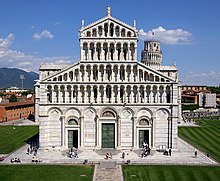Buscheto | |
|---|---|
 | |
| Died | September 21[1] |
| Resting place | Pisa Cathedral |
| Other names | Busketus, Buschetto, Boschetto, Bruschettus |
| Occupation | Architect |
| Years active | 1063-1110 |
| Buildings | Pisa Cathedral |
Buscheto or Busketus (sometimes also Buschetto or Boschetto, early Latin writers also used Bruschettus,[2] active in Pisa between 1063 and 1110[3]) was an Italian architect. He designed the plans for Pisa's Cathedral Square (Piazza dei Miracoli) and thus created the distinct Pisan Romanesque design style used throughout the square.[4] Buscheto had unitary vision fusing together architectural ideas of classical Rome, Byzantine, Arab, and Lombard Romanesque architectures, placing him amongst the best architects of the 11th and 12th centuries.[4]
Very little is known about Buscheto;[4] claims that he was a Greek from Dulichium are based on a misreading of the epitaph. Leopoldo Cicognara had assumed Buscheto's Italian origin based on his name, yet Leader Scott points out that this can be a nickname.[5] Approaches utilized by the architect cannot be explained by local traditions[4] (Pisa likely did not even have its own school of architecture before Buscheto[5]). Buscheto's style suggests first-hand familiarity with Early Christian, Byzantine, and Islamic architecture.[6]
Just two contemporary documents definitely identify Buscheto, as they identify him as one of the administrators (Operai) of the Pisa cathedral;[6] one is dated December 2nd, 1104, another - April 2nd, 1110. Researchers think that he designed the cathedral and started its construction in 1063 while still being a young man, and continued work on the project into the 1100s.[4]
- ^ Ascani 1993, "died on 21 September 1110 or one of the years immediately following".
- ^ Scott 1899, Note 159.
- ^ Sanpaolesi (1975). "Buscheto or Busketus". A Dictionary of Architecture and Landscape Architecture. Oxford Reference.
- ^ a b c d e Barsali 1972.
- ^ a b Scott 1899, p. 209.
- ^ a b Grove 2012, p. 472.